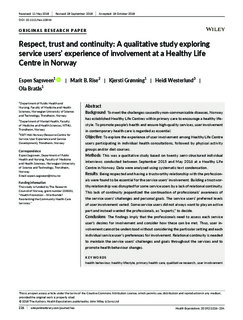| dc.contributor.author | Sagsveen, Espen | |
| dc.contributor.author | Rise, Marit By | |
| dc.contributor.author | Grønning, Kjersti | |
| dc.contributor.author | Westerlund, Heidi | |
| dc.contributor.author | Bratås, Ola | |
| dc.date.accessioned | 2019-09-19T08:13:04Z | |
| dc.date.available | 2019-09-19T08:13:04Z | |
| dc.date.created | 2019-01-17T18:08:40Z | |
| dc.date.issued | 2018 | |
| dc.identifier.issn | 1369-6513 | |
| dc.identifier.uri | http://hdl.handle.net/11250/2617575 | |
| dc.description.abstract | Background
To meet the challenges caused by non‐communicable diseases, Norway has established Healthy Life Centres within primary care to encourage a healthy lifestyle. To promote people's health and ensure high‐quality services, user involvement in contemporary health care is regarded as essential.
Objective
To explore the experience of user involvement among Healthy Life Centre users participating in individual health consultations, followed by physical activity groups and/or diet courses.
Methods
This was a qualitative study based on twenty semi‐structured individual interviews conducted between September 2015 and May 2016 at a Healthy Life Centre in Norway. Data were analysed using systematic text condensation.
Results
Being respected and having a trustworthy relationship with the professionals were found to be essential for the service users’ involvement. Building a trustworthy relationship was disrupted for some service users by a lack of relational continuity. This lack of continuity jeopardized the continuation of professionals’ awareness of the service users’ challenges and personal goals. The service users’ preferred levels of user involvement varied. Some service users did not always want to play an active part and instead wanted the professionals, as “experts,” to decide.
Conclusions
The findings imply that the professionals need to assess each service user's desires for involvement and consider how these can be met. Thus, user involvement cannot be understood without considering the particular setting and each individual service user's preferences for involvement. Relational continuity is needed to maintain the service users’ challenges and goals throughout the services and to promote health behaviour changes. | nb_NO |
| dc.language.iso | eng | nb_NO |
| dc.publisher | Wiley | nb_NO |
| dc.rights | Navngivelse 4.0 Internasjonal | * |
| dc.rights.uri | http://creativecommons.org/licenses/by/4.0/deed.no | * |
| dc.title | Respect, trust and continuity: A qualitative study exploring service users’ experience of involvement at a Healthy Life Centre in Norway | nb_NO |
| dc.type | Journal article | nb_NO |
| dc.type | Peer reviewed | nb_NO |
| dc.description.version | publishedVersion | nb_NO |
| dc.source.journal | Health Expectations | nb_NO |
| dc.identifier.doi | 10.1111/hex.12846 | |
| dc.identifier.cristin | 1659749 | |
| dc.description.localcode | © 2018 The Authors. Health Expectations published by John Wiley & Sons Ltd This is an open access article under the terms of the Creative Commons Attribution License | nb_NO |
| cristin.unitcode | 194,65,20,0 | |
| cristin.unitcode | 194,65,35,0 | |
| cristin.unitname | Institutt for samfunnsmedisin og sykepleie | |
| cristin.unitname | Institutt for psykisk helse | |
| cristin.ispublished | true | |
| cristin.fulltext | original | |
| cristin.qualitycode | 1 | |

